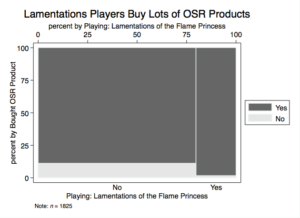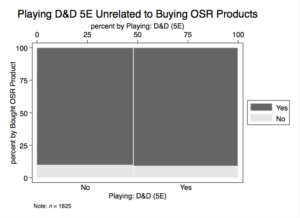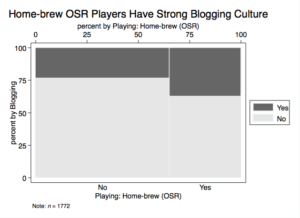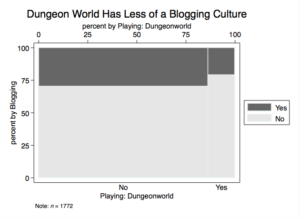(This is part of an ongoing discussion of the 2018 OSR Survey results. See the table of contents at the bottom of this post for links to the other parts.)
Particular tabletop roleplaying games are, in addition to being bundles of rules and subcultural traditions, commercial products and brands. Considering games as brands bridges the three broad aspects: commerce, rules, and social behavior. In this post, I will examine which group of players, by game, is most likely to have bought an OSR product, most likely to participate in long form discussion online (blogging), and most likely to publish their own game products for sale. The high level takeaways are:
- Those most likely to buy OSR products, Lamentations of the Flame Princess players, were no more likely to blog or create OSR products themselves.
- Swords & Wizardry players seem most likely to be both engaged in all three aspects, being the only group of players having positive associations with both buying and blogging. (I think it is reasonable to interpret blogging as both rules and social engagement.)
- Just based on examination, there seems to be some clustering of B/X D&D, Swords & Wizardry, Labyrinth Lord, and B/X Essentials, probably due to the high similarity of these rulesets.
The wordings of the relevant survey questions, along with aggregate descriptive statistics, were:
- Have you ever bought an OSR product? (Yes/No)
- Total n = 1825, Yes = 1657 (91%), No = 168 (9%)
- Do you have a blog where you post about tabletop roleplaying games? (Yes/No)
- Total n = 1772, Yes = 503 (28%), No = 1269 (72%)
- Have you created a tabletop roleplaying game product for purchase that you would consider OSR? (Yes/No)
- Total n = 1793, Yes = 253 (14%), No = 1540 (86%)
These three questions represent, in some ways, a hierarchy of effort, or engagement with, tabletop roleplaying as a hobby. It is easier to buy than to blog and easier to blog than to create more finished products.
To examine the association between playing various games and the three outcome variables, I ran pairwise tetrachoric correlations. The following table shows associations between playing particular games and having bought an OSR product. Read the “rho” column as strength of association, ranging from -1 (for perfect negative correlation) to 1 (for perfect correlation). (Rho is the tetrachoric equivalent to a Pearson product-moment correlation.) You may notice, looking at the two mosaic plots, that substantively the difference seems small. This is likely partly due to artificially constrained variance—recall that 91% of respondents reported having bought an OSR product. The buying measure was yes/no, so was unable to distinguish between people who buy a little and people who buy a lot, so I suggest interpreting the following statistics mostly as directional trends. The same goes for the other two measures, though the pattern is starker for blogging, where the measure was able to capture more variation.
| Players of… | N | rho | SE | p |
|---|---|---|---|---|
| Lamentations of the Flame Princess | 1825 | .44 | .08 | < 0.001 |
| Swords & Wizardry | 1825 | .44 | .08 | < 0.001 |
| Labyrinth Lord | 1825 | .43 | .08 | < 0.001 |
| B/X Essentials | 1825 | .41 | .08 | < 0.001 |
| Runequest | 1825 | .32 | .09 | 0.012 |
| Home-brew (OSR) | 1825 | .31 | .05 | < 0.001 |
| Dungeon World | 1825 | .16 | .07 | 0.026 |
| Vampire: The Masquerade | 1825 | -.16 | .07 | 0.021 |
Playing Vampire was the only significant negative association. Playing other games had no association with having bought an OSR product. The upshot of all this is that Lamentations of the Flame Princess players were most likely to have bought OSR products. Curiously, Dungeon World surfaces here again, perhaps because OSR products can easily inform Dungeon World games in terms of themes and content even if other aspects of the games differ. The n here is constrained by people that answered the buy question.
| Players of… | N | rho | SE | p |
|---|---|---|---|---|
| Home-brew (OSR) | 1772 | .25 | .04 | < 0.001 |
| Home-brew (other) | 1772 | .21 | .04 | < 0.001 |
| Swords & Wizardry | 1772 | .11 | .05 | 0.027 |
| Dungeon World | 1772 | -.14 | .05 | 0.005 |
| Shadowrun | 1772 | -.17 | .06 | 0.008 |
| Players of… | N | rho | SE | p |
|---|---|---|---|---|
| Home-brew (OSR) | 1793 | .34 | .04 | < 0.001 |
| Home-brew (other) | 1793 | .29 | .05 | < 0.001 |
| Swords & Wizardry | 1793 | .29 | .05 | < 0.001 |
| Labyrinth Lord | 1793 | .23 | .05 | < 0.001 |
| B/X D&D | 1793 | .23 | .05 | < 0.001 |
| B/X Essentials | 1793 | .23 | .06 | < 0.001 |
| D&D (1E) | 1793 | .23 | .06 | < 0.001 |
| Pathfinder | 1793 | -.14 | .06 | 0.038 |
| Apocalypse World | 1793 | -.19 | .07 | 0.013 |
Note that the blogging question was general rather than OSR-specific. You can find the full list of games that I asked about in the OSR Games post, along with the number or respondents that reported playing each game. There was also a free-response other option to capture any games I missed; there were no standouts in that item.
The number of pairwise hypothesis tests I ran for this post may seem high—21 games × 3 outcomes = 63—but the chance that most of these results came from chance alone is vanishingly small. One would expect approximately 3 spurious correlations at the .05 level, assuming no relationships exist in reality (3 ~= 5% of 63). As you can see, there were many more associations than 3 in this data, and with significance values that would be highly unlikely to see from chance alone, despite the relatively insensitive binary measures.





Pingback: CAR-PGa NEWSLETTER Vol. 28, No. 4, April 2019 – CAR-PGA